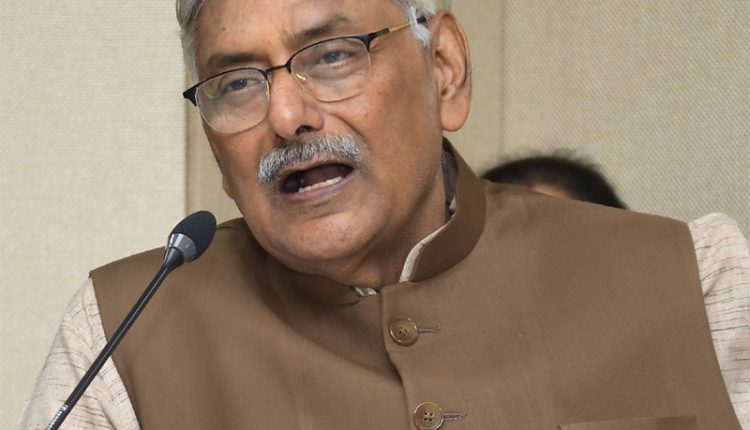And to ensure appropriate standardized treatment and rehabilitation of its victims
New Delhi,(Kalinga Voice) :The National Human Rights Commission, NHRC, India, headed by Mr. Justice Arun Mishra, has issued an Advisory to the Centre, States and UT Administrations to prevent and minimize the impact of ocular trauma and to ensure appropriate standardized treatment and rehabilitation of victims of ocular trauma, which causes about five percent of irreversible or permanent blindness.
The Commission has observed that major contributors of eye injury are road accidents (34%), sports (29%) and occupations (21%). However, the most reassuring fact is that eye injury is a preventable cause of blindness.
The Commission, among several important recommendations, has asked them particular to identify the industries having high potential of ocular trauma and other industrial accidents and make it mandatory for owners of all such industries employing minimum fifty (50) workers to purchase personal accident cover of minimum Rs. 15 lakh for each workers engaged by them. Establishment of a special fund has also been recommended to provide financial assistance to victims of ocular trauma.
The Advisory has focused on five keys areas for action by the Centre, States and UT Administrations, these include Creation of a Database on Ocular Trauma, Prevention and Minimization of Ocular Trauma, Treatment of Ocular Trauma, Development of Integrated ophthalmic trauma units and Rehabilitation of Victims of Ocular Trauma.
The detailed advisory may be accessed on the website of the Commission i.e. www.nhrc.nic.in .
Some of the important recommendations, among others, are as follows:
(i) Establish an online (web-based) portal or make provision in any existing portal, to record details of each case of ocular trauma; the details should include the mechanism, circumstances and objects causing the ocular trauma;
(ii) Make every single case of ocular trauma notifiable across the country with appropriate rule/regulation/guidelines to make it mandatory for each hospital or medical practitioner to upload details of each case of ocular trauma dealt by them;
(iii) Involve Integrated Child Development Scheme (ICDS) workers and school teachers to identify the victims of ocular trauma, counsel such victims to avail treatment and upload details of such victims on the online portal;
(iv) Create public awareness on major causes of ocular trauma and the care and precautions to be taken to address these causes;
(v) Identify the fire-crackers which have potential to cause eye trauma and impose a ban on use of such fire-crackers;
(vi) Impose ban on sale of bows, arrows, pellet guns, toys having sharp edges, and such other toys having potential to cause eye injuries;
(vii) Examine existing laws providing for mandatory use of eye safety gear by workers engaged in activities having potential to cause eye injuries;
(viii) Organize eye check-up camps in schools, colleges, slums, industrial clusters and rural areas to detect cases of untreated ocular trauma;
(ix) Promote clean fuel and well ventilated kitchen to prevent eye damage to persons engaged in cooking at homes, restaurants and community kitchens;
(x) Regulate chemicals identified as hazardous by dual packaging, restriction on sale to children and proper disposal of used chemicals and containers;
(xi) Prohibit sale of lime powder in thin plastic sachets;
(xii) Make it mandatory that all chemicals for domestic use should be packed in safe containers marked with caution symbols;
(xiii) Introduce technology to reduction in ocular trauma cases due to road accidents;
(xiv) Upgrade and expand the facilities for treatment of ocular trauma as a separate sub-specialty in Ophthalmology and increase availability of adequate number of Ophthalmologists with adequate number of equipment and other facilities;
(xv) Create a post of Ophthalmologist in each Community Health Centre and increasing the number of posts of Ophthalmologists in District Hospitals, Medical Colleges, All India Institute of Medical Sciences (AIIMS) and other Specialty Health Care Centres;
(xvi) Sponsor research in the field of ocular trauma to facilitate development of low cost eye care technologies;
(xvii) Upgrade eye/cornea banks by building awareness about eye donation and creation of an online portal to register voluntary pledge for eye donation;
(xviii) Set-up integrated ophthalmic trauma care units across the entire country and impact training young ophthalmologists in handling and managing ocular trauma cases; and
(xix) Rehabilitate the victims of ocular trauma by organizing adjustment training for its victims and link online portal to be established for registration of victims of ocular trauma with the Unique Disability ID (UDID).

